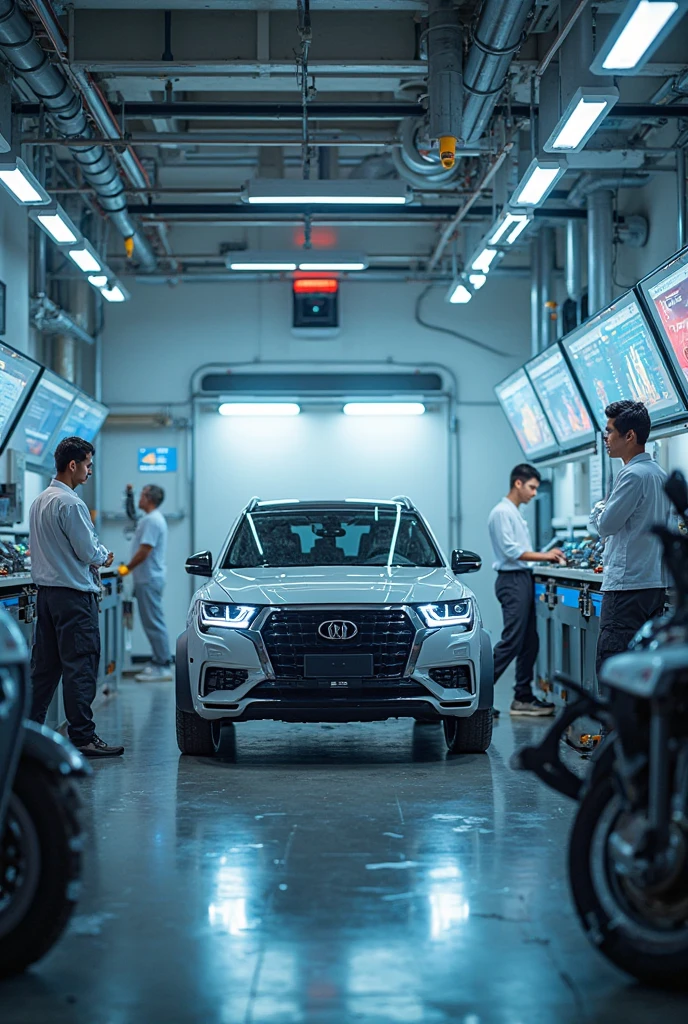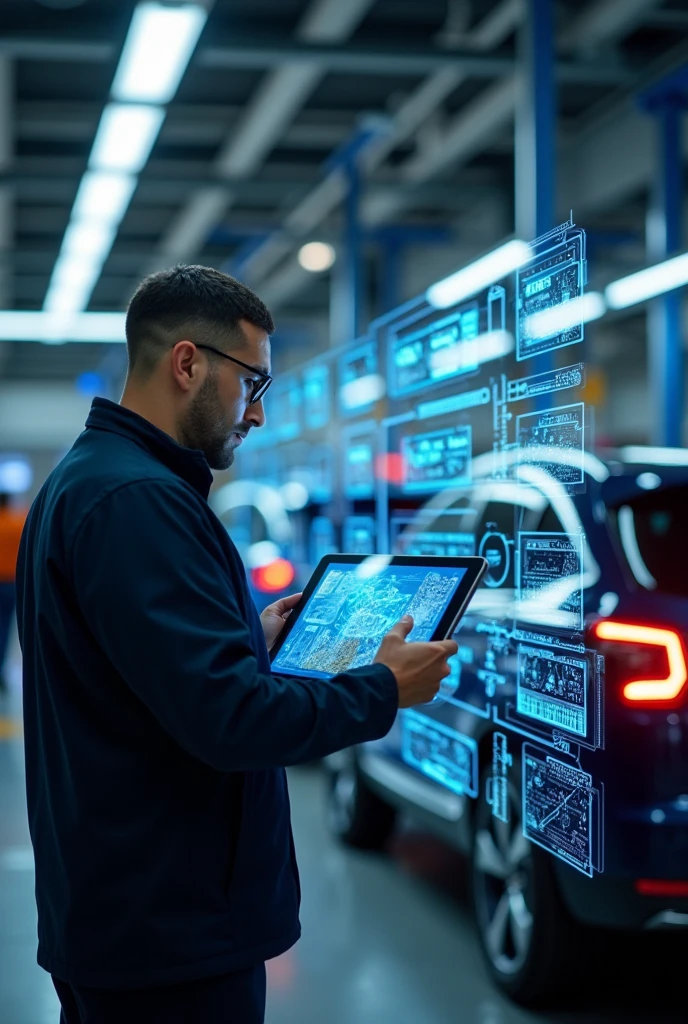Introduction: When Your Car Becomes a Computer on Wheels
When John Martinez brought his vehicle to the repair shop last month, he wasn’t greeted by a mechanic with grease-stained hands and basic tools. Instead, a technician wielding a tablet connected his car to a sophisticated diagnostic system that communicated with every electronic component in the vehicle. Within minutes, the problem was identified—not through guesswork or trial-and-error, but through data analysis and digital diagnostics.
Welcome to the world of modern automotive service technology, where advanced diagnostics, connectivity, and electrification have fundamentally changed how vehicles are maintained and repaired. Gone are the days when mechanics relied solely on intuition and experience. Today’s automotive service technicians are high-tech problem solvers who combine mechanical knowledge with digital expertise.
The transformation of automotive service technology represents one of the most significant shifts in the transportation industry. As vehicles become increasingly complex—essentially computers on wheels—the skills, tools, and knowledge required to service them have evolved dramatically.
The Growing Automotive Service Technology Market
The global automotive service technology market is experiencing unprecedented growth. According to recent data, the vehicle-to-everything (V2X) communication technology market alone was valued at $19.94 billion in 2024 and is projected to grow at a compound annual growth rate (CAGR) of 42.2% from 2025 to 2030.
This remarkable expansion is driven by several factors:
- Rising complexity of modern vehicles
- Integration of advanced electronics and software
- Growth in electric vehicle adoption
- Increasing consumer expectations for quick, accurate service
- Government regulations pushing for safer, more efficient vehicles
The employment outlook for automotive service technicians reflects this growth. The U.S. Bureau of Labor Statistics projects a 3% growth in employment for automotive service technicians and mechanics from 2023 to 2033, with approximately 67,800 job openings annually over the decade. This steady demand underscores the essential role these professionals play in keeping our increasingly sophisticated vehicles on the road.
Top Innovations in Automotive Service Technology for 2025

The automotive service technology landscape is being reshaped by revolutionary innovations that are changing how technicians diagnose, maintain, and repair vehicles. Here are the most significant developments transforming the industry
1. Advanced Diagnostic Systems
Modern diagnostic tools have evolved far beyond the simple code readers of the past. Today’s systems incorporate artificial intelligence to analyze vehicle data, predict potential failures before they occur, and guide technicians through complex repair procedures.
These smart diagnostic platforms can:
- Simultaneously monitor multiple vehicle systems
- Compare performance against manufacturer specifications
- Create detailed visual representations of system operations
- Recommend specific repair procedures based on real-time data
- Update automatically with the latest vehicle information
2. Augmented Reality (AR) Repair Assistance
Augmented reality is revolutionizing automotive service technology by overlaying digital information onto the physical world. Technicians wearing AR glasses can see step-by-step repair instructions projected directly onto the vehicle, highlighting exactly which components need attention.
This technology significantly reduces repair time while improving accuracy, particularly for complex procedures. It also serves as an effective training tool, allowing less experienced technicians to perform sophisticated repairs with expert guidance.
3. Electric Vehicle Service Solutions
The rapid adoption of electric vehicles (EVs) has created demand for specialized automotive service technology. According to Deloitte, between 18% and 36% of all vehicles sold in 2025 will be electrified, including battery electric vehicles, plug-in hybrids, and hydrogen fuel cell vehicles.
New service technologies for EVs include:
- High-voltage safety systems and protective equipment
- Battery diagnostic and maintenance tools
- Specialized cooling system service equipment
- Regenerative braking system analyzers
- Electric motor testing and repair solutions
Technicians require extensive additional training to safely and effectively work on these vehicles, creating new specializations within the field.
Real-Life Applications of Modern Automotive Service Technology
The impact of advanced automotive service technology extends across multiple aspects of vehicle ownership and maintenance. Here’s how these innovations are being applied in real-world settings:
Connected Car Maintenance
Today’s vehicles continuously monitor their own health and can communicate directly with service centers. This connectivity enables:
- Automatic scheduling of maintenance when needed
- Remote diagnosis of issues before bringing the vehicle in
- Over-the-air software updates to fix certain problems
- Personalized maintenance recommendations based on actual driving patterns
- Immediate notification of critical safety issues
For example, Tesla’s service centers can diagnose many vehicle issues remotely, sometimes fixing software-related problems without the owner ever needing to visit a shop.
Data-Driven Preventive Maintenance
Smart service technologies now allow for truly personalized maintenance schedules based on actual vehicle use rather than arbitrary mileage intervals. This approach:
- Reduces unnecessary maintenance costs
- Prevents unexpected breakdowns
- Extends vehicle lifespan
- Optimizes performance and efficiency
- Minimizes environmental impact through proper system operation
Companies like CarMD and Zubie offer consumer-friendly systems that provide ongoing monitoring and alerts before problems become serious.
Enhanced Customer Experience
Modern automotive service technology has transformed the customer experience at service centers:
- Digital inspection reports with photos and videos
- Real-time repair status updates via smartphone
- Online scheduling and automated reminders
- Electronic records of all service history
- Virtual consultations with technicians
These technologies create transparency, build trust, and eliminate much of the frustration traditionally associated with vehicle repairs.
Future Trends: What’s Next for Automotive Service Technology

The evolution of automotive service technology shows no signs of slowing. Here are the key trends that will shape the industry in the coming years:
AI Personalization and Predictive Analytics
Artificial intelligence will increasingly power predictive maintenance systems that can forecast potential failures with remarkable accuracy. These systems will analyze vast amounts of data from similar vehicles to identify patterns and warning signs before problems occur.
For service centers, this means:
- Proactive parts ordering based on predicted needs
- More efficient scheduling and resource allocation
- Higher first-time fix rates
- Reduced diagnostic time
- Improved customer satisfaction through prevention rather than repair
Brain-Computer Interface Applications
While still in early development, brain-computer interface technology could eventually revolutionize vehicle diagnostics and repair. Technicians might use thought-controlled interfaces to access repair information, control diagnostic equipment, or even operate specialized repair robots for difficult-to-reach components.
Mainstream Integration of Advanced Technologies
Technologies that currently exist primarily in high-end vehicles and specialized repair facilities will become standard across the industry:
- Automated repair systems for routine maintenance
- Robot assistants that work alongside human technicians
- 3D printing of replacement parts on-demand
- Virtual reality training systems for technicians
- Quantum computing for complex diagnostic challenges
As these technologies become more affordable and accessible, they will transform even small, independent repair shops.
Challenges Facing Automotive Service Technology
Despite its tremendous potential, the advancement of automotive service technology faces significant challenges:
Cost Barriers
The sophisticated equipment required for modern vehicle service comes with substantial costs:
- Advanced diagnostic systems can cost tens of thousands of dollars
- Ongoing software subscription fees for technical information
- Regular training requirements for technicians
- Specialized tools for new vehicle systems
- Facility upgrades to accommodate new technologies
These expenses can be particularly challenging for small, independent repair shops, potentially leading to industry consolidation.
Training Requirements
Today’s automotive technicians need far more extensive training than their predecessors:
- Understanding of complex electronics and computer systems
- Knowledge of multiple propulsion technologies (internal combustion, hybrid, electric)
- Ability to use sophisticated diagnostic equipment
- Digital literacy and software troubleshooting skills
- Continuous learning to keep pace with technological change
The Bureau of Labor Statistics notes that postsecondary education is increasingly becoming the norm for entry into this field, with many technicians completing associate’s degree programs.
Privacy and Security Concerns
As vehicles collect more data and become more connected, significant questions arise about:
- Who owns the data generated by vehicles
- How this information can be used and shared
- Protection against unauthorized access to vehicle systems
- Balancing diagnostic access with cybersecurity concerns
- Potential for remote exploitation of connected vehicles
The industry continues to work toward standards that protect consumers while enabling the benefits of connected automotive service technology.
Conclusion: The Road Ahead for Automotive Service Technology
The rapid evolution of automotive service technology represents both a challenge and an opportunity for the transportation industry. As vehicles become increasingly sophisticated, the knowledge and tools required to maintain them grow more complex. Yet these same advances are making vehicles safer, more efficient, and more reliable than ever before.
For consumers, the transformation means more transparent, convenient service experiences and fewer unexpected breakdowns. For technicians, it offers exciting career paths that combine mechanical expertise with cutting-edge technology skills. And for the automotive industry as a whole, it means a fundamental reimagining of the relationship between vehicles, their owners, and those who keep them running.
The future of automotive service technology will be shaped by those who can embrace these changes, invest in the necessary tools and training, and maintain a commitment to continuous learning. In this rapidly evolving landscape, the most successful professionals and businesses will be those who view technological change not as a disruption but as an opportunity to provide better service and create more value.
FAQ: Automotive Service Technology
What education is required to work in automotive service technology?
While some entry-level positions require only a high school diploma, most employers prefer candidates who have completed postsecondary education in automotive service technology. Programs range from six-month certificates to two-year associate’s degrees, with the latter becoming increasingly common. These programs combine classroom instruction with hands-on practice in areas such as electronics, computer systems, and specialized repair techniques.
How is electric vehicle service different from traditional vehicle maintenance?
Electric vehicles require specialized automotive service technology knowledge and tools. Technicians must understand high-voltage electrical systems, battery technologies, and regenerative braking systems. They also need specific safety training for working with high-voltage components. While EVs typically require less routine maintenance (no oil changes, fewer moving parts), diagnosing and repairing problems often involves sophisticated electronic systems and specialized equipment.
What certifications are important for automotive service technicians?
The most widely recognized certifications come from the National Institute for Automotive Service Excellence (ASE). ASE offers certifications in multiple specialties within automotive service technology, including engine repair, electrical systems, brakes, and suspension. Many employers require ASE certification, and technicians who earn certification in multiple areas can qualify for Master Technician status. Additionally, manufacturer-specific certifications are important for those working at dealerships.
How is artificial intelligence changing automotive service?
AI is transforming automotive service technology through improved diagnostics, predictive maintenance, and automated repair guidance. AI systems can analyze sensor data from vehicles to identify potential issues before they cause breakdowns, guide technicians through complex repairs with step-by-step instructions, and help service centers manage parts inventory and technician scheduling more efficiently. As AI technology advances, we can expect even more sophisticated applications that make vehicle maintenance faster, more accurate, and more convenient.
What’s the job outlook for careers in automotive service technology?
The employment outlook for automotive service technology professionals remains stable, with the Bureau of Labor Statistics projecting 3% growth from 2023 to 2033. Approximately 67,800 job openings are expected annually, primarily due to the need to replace workers who leave the field. Technicians with advanced training in electronics, hybrid/electric vehicles, and computer systems will have the best opportunities, as these specialized skills are increasingly in demand across the industry.

